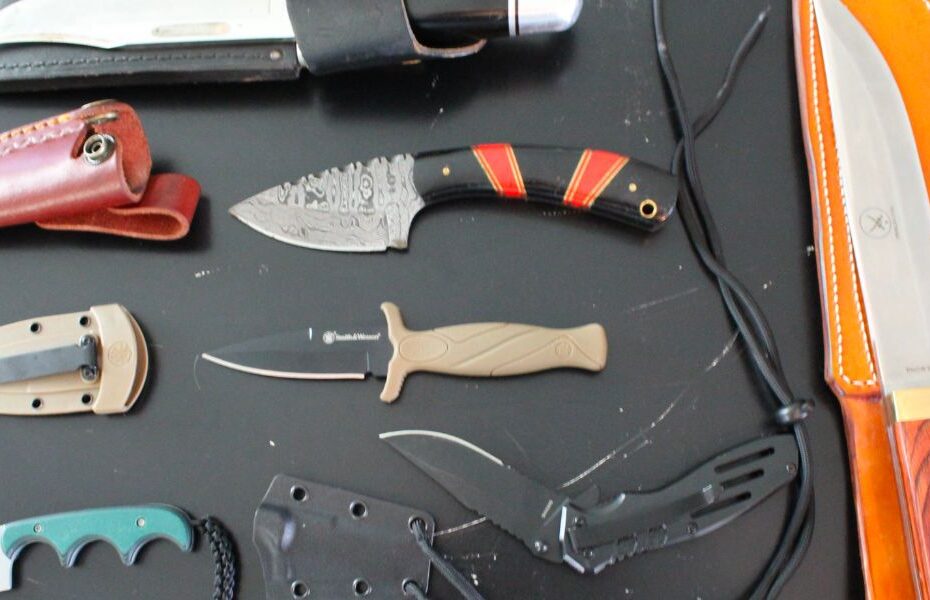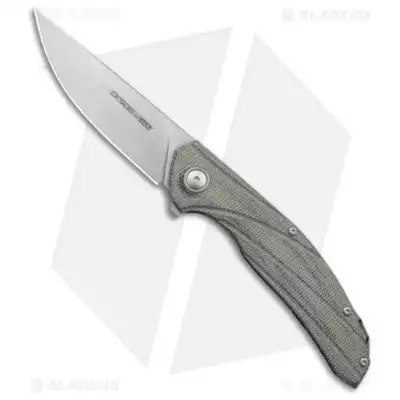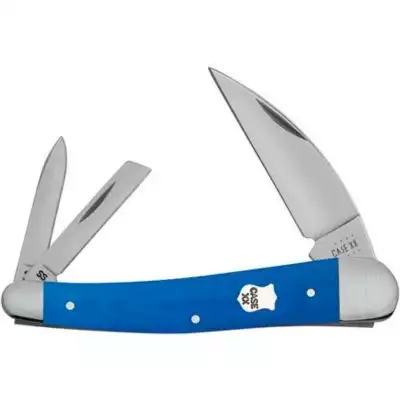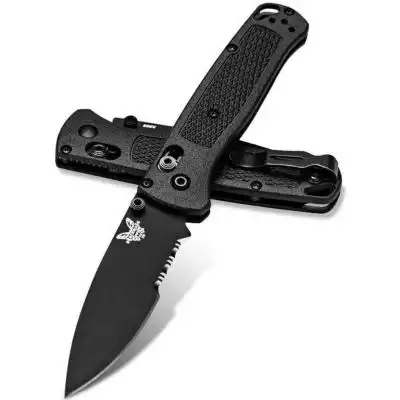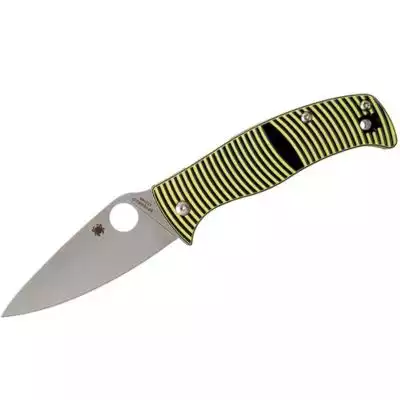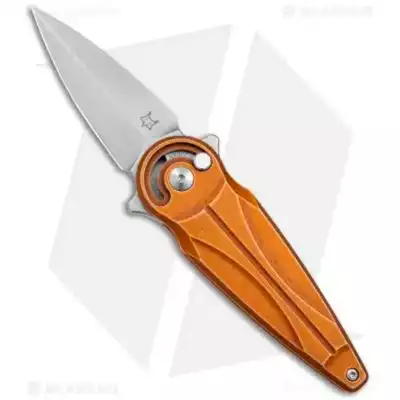[ad_1]
Pocket knives come in a wide array of shapes and sizes, from single Wharncliffe blades all the way to old-fashioned Congress configurations. Choosing the best lightweight EDC (everyday carry) pocket knife largely depends on your intent, purpose, and personal preference.
Whether you’re using your pocket knife to open a letter or package, cut a fishing line or rope, or start a fire, there are literally thousands to choose from.
To narrow your choices, I’ve limited the selection to the most useful blade shapes and knife patterns for everyday utility usage and SHTF purposes:
- Drop point
- Straight back
- Sheepsfoot
- Dagger
- Whittler
I’ve considered these 3 key criteria:
- Quality of the materials
- Durability
- Comfort
While there are dozens more to choose from, these five will serve the majority of everyday carry needs.
Our Top Pick
Viper Knives Anso Orso 2 V5998CG
The straight-back blade and high-quality materials make the Anso Orso the most durable and versatile lightweight EDC pocket knife.
Best for Versatility
Case XX 16747 Seahorse G10
The old-fashioned whittler style combines the Wharncliffe blade, a traditional pen knife, plus a coping blade to fulfill all your EDC tasks, whittling, and scribing needs.
Best Lightweight EDC Pocket Knife Reviews
Best All Around EDC Pocket Knife: Viper Anso Orso 2
Length: 8.25″ | Handle: 4.75″ | Blade: 3.4″ | Cutting edge: 3.4″ | Weight: 4 oz
Traditionally found on fixed blades, this puukko-style, straight-back blade makes the Viper Anso Orso the perfect workhorse for an EDC. From woodwork to food prep, the Viper is an all-around useful tool for heavy-duty cutting, piercing, skinning, and even bushcraft work.
The Viper Anso Orso 2 is made with unbeatable quality starting with the German-made LO-QPM 20-4 hardened stainless-steel blade, giving it superior edge retention and corrosion resistance.
Its toughness is rated around HRC60, so it can withstand chipping, cracking, and sudden impact damage when you drop it. The Viper blade is recessed into the handle just enough that you don’t accidentally grab it when reaching for it. The blade features a full, flat grind for a thicker, stronger blade with added toughness.
It has a comfortably contoured, top-notch Micarta handle with a titanium backspacer that ensures your blade stays straight and has the necessary space when opening and closing.
The handle is elegant, strong, and etched, giving it a hand-crafted organic feel. It also has a rock-solid titanium frame lock keeping your fingers safe and providing a wear-resistant interface between the frame and blade.
It features a tip-up, right-handed carry titanium pocket clip that keeps the blade spine guarded by your outside pocket seam. The clip is very pronounced off the body of the handle so it doesn’t snag on your belt or pocket.
The back of the blade has a short, stubby flipper-style opener with an extended tang. The pivot features caged ball bearings that make for a smooth and easy walk and talk.
The craftsmanship and quality of the Viper are truly impressive and make this the perfect EDC pocket knife that’s comfortable and lightweight. This knife is virtually maintenance-free whether you’re using it in the office, on the farm, or in the bush. Although a little on the larger side, you simply can’t beat the quality and durability.
Pros:
- Superior quality
- Versatile
- LO-QPM 20-4 hardened steel
- Ergonomically organic feel
- Great edge retention
- Corrosion resistance
- Fixed blade feel
Cons:
- Right-handed only
- Short, stubby flipper
- Too large for some
Best Whittler Pocket Knife: Case Seahorse Whittler Pocket Knife
Length: 6.375″ | Handle: 4″ | Blade: 2.375″ | Cutting edge: 2″ | Weight: 2.6 oz
If you’re looking for an everyday carry like Grandpa used to have, then look no further than Case’s Seahorse Whittler. It makes an excellent general-purpose utility knife. Its long, piercing tip is similar to a tanto-style guillotine, and its straight edge is useful for carving and whittling tasks.
Check Prices on Knife Country USA
This old-fashioned pocket knife features a primary Wharncliffe blade with a thick back for extra bite and durability. The Wharncliffe is one of the best blades for maximum cutting performance. It’s curved to a fine point with a straight-honed edge that’s useful for everyday tasks, camping, or carpentry work.
Its secondary blades include a traditional pen blade and a coping blade. Originally designed to sharpen quilled ink pens back in the day, the pen blade is great for everyday tasks like opening envelopes or boxes, cutting lightweight cordage, or food prep.
A preferred tool among carpenters and electricians, the coping blade is perfect for making cuts in tight areas, marking cut lines, or stripping wires.
All three blades are made with high-carbon Tru-Sharp stainless steel, a 420HC high in chromium, enhancing tensile strength for edge retention. Because its HRC is only in the neighborhood of 54–57, many wielders consider Tru-Sharp low-grade steel that’s too soft for their preference.
However, just as many prefer the Tru-Sharp for its easy sharpening and worry-free maintenance. Its hollow grind is thin enough that what it lacks in hardness, it makes up for in edge. Plus, its blade geometry helps it hold an edge longer.
Out of the box, the edge is rough and prone to having burrs. You’ll need to spend some time grinding it down and honing it back. However, once you get it where you want it, it’s easy to maintain and well worth the effort.
The G10 handle comes in a variety of colors and styles, is lightweight, and incredibly strong with a comfortable grip. It’s ergonomically comfortable, accommodating a full grip with no hot spots. The Seahorse has good spring tension with a nick nail opener but has a no-lock slip joint mechanism that can close on your fingers if you’re not careful.
However, the walk and talk features smooth deployments with clean snaps. All three blades slip in and out with good clearance and no rubbing.
If you’re looking for the traditional whittling pocket knife, the Seahorse bites and cuts well and is perfect for notching and carving. This is the perfect knife for traps and snares, creating feather sticks, or making a bow drill kit.
Overall it’s a well-finished knife, and the panels taper nicely to the brass. There are no gaps along the spine, and there is little to no wobble in the blade. Because it’s a traditional pocket knife, it doesn’t feature a pocket clip, which may be a turn-off to some.
Pros:
- Well-crafted design
- Superb edge
- Multifaceted use
- Comfortable and sturdy handle
- Ambidextrous
- Fits well in the pocket
Cons:
- No pocket clip
- Blade requires touch up out of the box
- Slip joint mechanism
- Budget steel
Best Drop Point: Benchmade Bugout Axis
Length: 7.46″ | Handle: 4.22″ | Blade: 3.24” | Cutting edge: 3″ | Weight: 1.8 oz
One of the most popular blade designs for hunters and fishermen is the drop-point blade. Its convex spine curves from handle to point, giving it a strong tip. Additionally, its wide belly makes it the perfect option for slicing and meat processing.
If you’re looking for the perfect lightweight hunting and fishing pocket knife, I like the Bugout Axis. Its CPM-S30V stainless steel blade features a great balance between corrosion resistance, edge retention, and toughness.
Its HRC averages around 58–60, which is about four times greater than the 440C, resulting in exceptional hardness and wear resistance. The thinness of the blade makes it superb for slicing.
The handle is CF-Elite for a super lightweight, attractive, and strong four-finger grip. It has a slim and comfortable profile making it ideal for those with smaller hands. Additionally, there’s an oversized lanyard hole for tethering.
The Bugout Axis’s reversible, tip-up, deep-carry pocket clip makes it ambidextrous. However, the handle is a little on the slick side, and with prolonged use, the clip digs into the palm.
The walk and talk is superb, with Black titanium thumb studs on both sides of the blade and high-quality bronze washers. It also features the original Benchmade Axis lock that presses into the backstop, keeping the knife open and protecting your fingers.
Pros:
- Superior blade steel
- Super light
- Exceptional hardness and toughness
- Great edge retention
- Corrosion resistance
- Ambidextrous
Cons:
- Slick handle
- Clip creates hot spot
Best Sheepsfoot Blade: Spyderco Caribbean Sheepsfoot Folding Knife
Length: 8.54″ | Handle: 4.48″ | Blade: 3.7” | Cutting edge: 3.67″ | Weight: 4.2 oz
For those who prefer blunt-tip knives, the Spyderco Caribbean sheepsfoot is a great option. This is the perfect lightweight EDC pocket knife for emergency responders and mariners.
The blunt tip of the Spyderco Caribbean makes it the perfect tool for cutting seat belts or clothing from those in distress and would make a great addition to any medical kit or bug-out bag.
The blade is crafted with LC200N ultra stainless steel, which is high in nitrogen. This superior-quality blade is 100% corrosion resistant, making it the perfect lightweight EDC for those around water. It has a full-flat grind and is very thin behind the edge.
Unfortunately, at 3.7″, this blade may be too long for some to legally carry.
Its HRC ranges from 58–60, providing excellent edge retention and water resistance. The Spyderco Caribbean can do a lot of cutting without getting dull. When you do sharpen, it’s easy to get a razor-sharp edge with little effort. The Caribbean Sheepfoot has the added option of a plain or serrated SpyderEdge.
The blade features Spyderco’s trademarked thumb-hole opening mechanism and compression lock with a leaf spring that engages in the blade tang cutout, ensuring the blade stays open until you release it.
Additionally, the highly sought-after phosphor bronze washer offers superior walk and talk.
The handle is made from high-quality, strong, and lightweight G10 construction with alternating colored layers to create a ribbed, nonslip grip. It’s comfortably contoured and big enough to use with gloves without obstruction, which also makes it ideal for larger hands. It also features a blade guard on both ends.
There’s a reversible titanium pocket clip that supports ambidextrous carry, as well as a lanyard hole for tethering. However, the pocket clip isn’t centered, which creates a little bit of friction when pulling it in and out of your pocket.
While the Caribbean is a quality, purpose-driven knife, it is big, which may not be ideal for many people. Aesthetically, it leaves a little something to be desired.
Pros:
- 100% corrosion resistant
- Excellent edge retention
- Easy to sharpen
- Quality construction
- Requires little to no maintenance
Cons:
- Too large for some
- Long blade
- On the high-end of lightweight
Best Dagger Blade: Fox Saturn Folding Knife
Length: 6.61″ | Handle: 4.05″ | Blade: 2.56” | Cutting edge: 3″ | Weight: 3.6 oz
Dagger blades are specifically designed for piercing with cutting edges on both sides of the blade for fast entry and exit. As such, they’re usually found on tactical knives. For the ultimate self-defense lightweight EDC pocket knife, the Fox Saturn tops my list. Its symmetrical dagger design is ideal for both piercing and slicing.
To start, the blade is crafted with superior N690 Bohler steel, which is finely grained, cobalt-enriched stainless steel. This provides a fine edge with enhanced retention superior to most other stainless formations. Its HRC averages between 55 and 60, providing the perfect balance between hardness and toughness.
The blade features a unique radial-slide opening mechanism with an extended tang and button lock to firmly hold the blade open.
The copper-anodized aluminum handle is low-density, giving it a nice feel without too much weight. While the aluminum handle is a quality build, it can scratch and dent rather easily compared to other choices.
It has a nice tapered design with a four-finger grip and a single-barrel spacer, providing your blade with plenty of clearance on the walk.
The handle also features an aluminum, tip-up, right-side belt clip.
Pros:
- Superior N690 Steel
- Quality aluminum handle
- Balanced hardness and toughness
- Enhanced edge retention
Cons:
Buyers’ Guide
There are a few key features that you should look for in a lightweight EDC pocket knife, many of which are subjective. However, these elements warrant careful consideration.
Weight
Most consider anything under three ounces to be lightweight. However, I like my blades to pack a bit more punch or they feel too flimsy.
Working outdoors all day often requires something a bit more rugged, so I usually prefer a larger pocket knife, which just naturally carries more weight. I’ve also found superlight blades to be a disappointment. Lightweight is one thing, but a flimsy knife won’t do you much good.
My threshold for a lightweight blade hovers under five ounces, but this is merely a personal preference.
Blade
Arguably the most important part of the knife, you want a blade made from fine-quality steel. You want a decent blade that combines hardness with toughness. If it’s too hard, it’s prone to cracking and chipping, and if it’s too soft, your edge will wear away quickly.
You’ll typically find knife blades in a variety of fashions, but all are usually made from one of three choices.
- Stainless steel
- High-carbon steel
- Tool steel
High-carbon blades usually feature better hardness, toughness, and edge retention. They’re also easier to sharpen, obtain a sharper edge, and hold their edge much longer than stainless steel. Conversely, they’re also more prone to corrosion.
Toughness and Corrosion Resistance
A blade’s toughness is typically measured using the Rockwell Hardness Scale (HRC). Most pocket knives fall into these three categories:
- HRC 56–58: A premium knife that retains its sharpness for a longer period and is easy to sharpen
- HRC 58–60: Standard hardness of most pocket knives; will retain sharpness longer but more difficult to sharpen
- HRC 60–62: Prone to brittleness and challenging to sharpen
Improved corrosion resistance usually results in a loss of toughness, hardness, and edge retention. However, you want your EDC lightweight pocket knife to withstand daily wear and tear. Pocket knives are usually exposed to dirt, water, and chemicals that cause rust.
Corrosion resistance is usually achieved by adding Chromium, but metallurgists add a variety of other ingredients that enhance a blade’s features:
- Carbon: Improves hardness
- Cobalt: Adds strength and increases hardness
- Chromium: Adds corrosion resistance, wear resistance, and increases hardness
Blade Design
Specific blades are designed for purpose-driven tasks. Many times you’ll see poor knife reviews as a result of said knives being used for tasks other than what they were intended for.
In my opinion, these are the most common purpose-driven blade designs and the central focus for this round-up:
- Drop point: Best for opening boxes, slicing, and meat processing
- Straight back: Best for piercing, skinning, and bushcraft tasks
- Sheepsfoot: Blunt nose to avoid puncturing, best for medics, emergency responders, and mariners
- Dagger: Double-edged blade perfect for self-defense
- Whittler: A universal utilitarian knife best for woodworking and scribing
In addition to blade design, some tasks call for a straight blade, whereas others need a serrated one.
A straight blade is much easier to sharpen, more versatile, and more useful for most cutting tasks involved in everyday use. Serrated blades have their purpose when dealing with thick ropes and branches but aren’t necessary for everyday use.
Handle Construction
Next to the blade, the handle is essential to a quality EDC lightweight pocket knife. These are the most common and durable options for the average pocket knife:
- Bone
- Wood
- Aluminum
- Carbon fiber
- G10
- Fiberglass reinforced nylon
- Stainless steel
- Titanium
- Micarta
Locking Mechanism
Whenever plausible, your pocket knife should have some sort of locking mechanism to keep your fingers intact.
There are several options and some are easier to operate than others, so it’s a good idea to make sure you can safely close the knife with whatever mechanism it has in place. Occasionally, you’ll find one that’s so difficult to close it’s challenging not to chop your fingers off in the process.
Walk and Talk
The walk and talk of your pocket knife refers to how well the blade opens and closes. The walk refers to the feel of the tang as it moves along the knife’s spring. The talk is the sound the knife makes when the blade opens and closes.
A good walk and talk has a strong snap on the open and a smooth glide across the springs. The blade should be perfectly aligned with the handle and the barrel should provide adequate space to prevent any rubbing against the liner or other blades.
You shouldn’t feel any friction or hangups on the walk, and the opening mechanism should provide one fluid motion without any resistance. You shouldn’t hear any additional clicks or clacks on the talk except for the single snap of the blade popping into place behind its locking mechanism.
Other Knife Anatomy
Don’t overlook the nuts and bolts of your knife. They’ll be most prone to wear, tear, and rust, so make sure they’re made from quality materials. These are the ones that usually fail:
- Pivots and washers
- Frame screws
- Barrel spacers
- Pocket clips
- Handle scales
- Liners
Aluminum, high-carbon steel, or titanium are always excellent choices. Avoid nylon and Teflon washers.
Conclusion
I love the Viper Anso Orso for its puukko-style bushcraft durability in a lightweight folding blade. It makes the perfect outdoor utility knife for work on the homestead. However, on those days when I require something a little more discreet, Case’s Seahorse Whittler fits nicely into a small pocket.
[ad_2]
Source link
